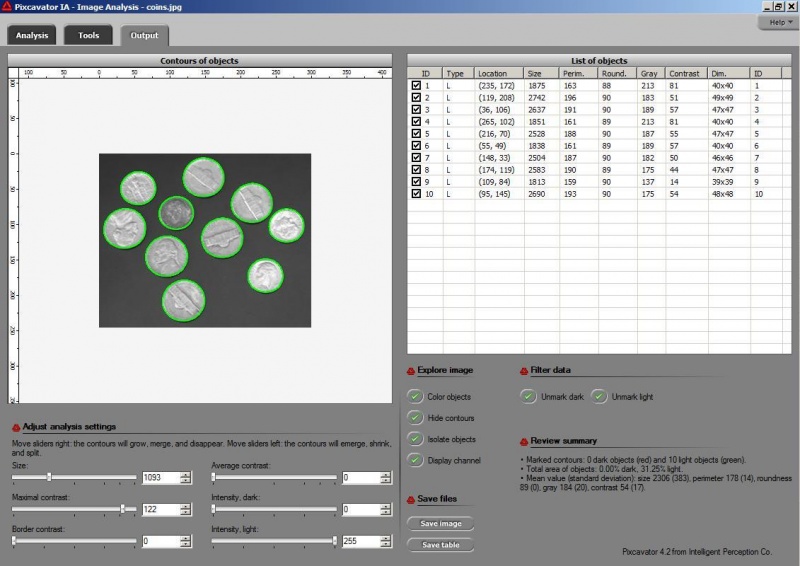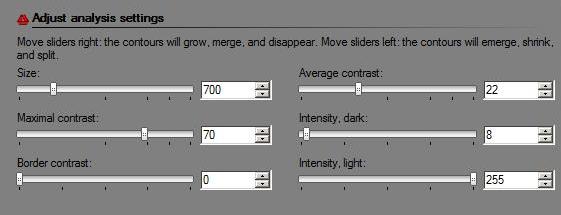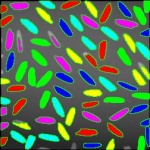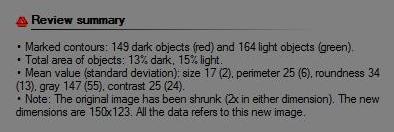This site is devoted to mathematics and its applications. Created and run by Peter Saveliev.
Output tab
From Intelligent Perception
Pixcavator's output tab contains the analysis data and, in addition, allows the user to change the analysis settings and see immediate effects.
One arrives to this tab by pressing Run in the Analysis tab (the tab is disabled until the image has been analyzed).
During this stage a data structure, called the topology graph, is created that contains complete information about all possible segmentations of the image.
Contents
1 Output image
The analyzed image is displayed on the left. Each object that has been detected is captured with a contour. Dark objects are outlined with red and light with green. To understand what these contours are exactly, read Boundaries in gray scale images. You can pan the image with the left button of your mouse and magnify with the right button.
If you click within the image while holding Ctrl, the nearest object to your mouse will switch its marked status: marked become unmarked and vice versa. If, in addition, you move the mouse, the objects close to the rectangle spanned this way will switch. As a result, the corresponding contours will appear or disappear.
Up to 2000 contours are shown on the image and their statistics (see below) is also displayed. When there are more than 2000 contours, neither is shown.
2 Output table
On the right, there is a table containing all objects in the image satisfying the current analysis settings. For each objects the following data is displayed:
- light or dark,
- location (coordinates of the centroid = the center of mass of the object as a lamina of uniform density),
- size (the number of pixels = area),
- perimeter,
- roundness (above 80 for circles, less for everything else),
- intensity (max/min level of gray),
- location of the center of mass (of the object as a lamina with density = gray level), -- not currently
- average contrast (saliency/size),
- thickness and length.
For more information, see Pixcavator's output table.
This table, combined with the settings, statistical summary etc, can be saved to hard disk in the form of a spreadsheet by pushing Save table.
3 Change analysis settings with sliders
There are six sliders on the left that allow you to edit the analysis settings. The objects that fall below these thresholds will be ignored by the analysis procedure and not counted (to understand what we consider an object in an image read Objects in gray scale images).
The text reads: "Move sliders right: the contours will grow, merge, and disappear. Move sliders left: the contours will emerge, shrink, and split." To see how moving the sliders change the contours see this short clip.
First, choose a threshold for Size. For example, if you choose 100, every object containing less than 100 pixels will not captured or counted. The Size slider is set automatically depending on the size of the image.
Second, choose a threshold for Contrast. For example, if you choose 20, every object surrounded by an area with gray level that differs from that of the object by less than 20 will be ignored. There are 256 levels of gray.
This is how it works with these two sliders: the objects in the image are allowed to grow – from one level of gray to the next - up to the extent set by the slider (see Boundaries in gray scale images). For example, the object will grow until it’s both larger than say 100 pixels and has contrast above 20.
The third, Border contrast, slider is very different from the other two. Here, the object is allowed to expand – from one level of gray to the next - as long as its border moves less than a certain amount. Roughly, the expansion stops once the contour reaches a sharp edge. (To reproduce results you obtained with versions 3.0 and earlier, keep this value at 0.) Both this and the second slider consider the difference in intensity inside the object from that of the surrounding area. But, while the contrast slider considers the maximal difference throughout the object ("Max contrast"), the border contrast slider looks at the area just inside the contour. The result is: it detects sharp edges, i.e. the contours with the largest difference between what’s just inside and what’s just onside of it.
The fourth slider works similarly to the third but takes into account the average difference in intensity inside the object from that of the surrounding area. It’s called the Average contrast.
The last two sliders simply threshold the image. For example, if you set Intensity, dark, to 100, the contours of dark objects displayed will have the intensity equal to exactly 100. If you set Intensity, light to 100, the contours of light objects will the intensity equal to exactly 155 (here 155=255-100). The last slider was set this way in order to ensure that contours grow as you move any of the six sliders from left to right. This is a somewhat unsophisticated tool but it’s very effective when the image lighting is uniform.
Keep in mind that if the analysis results are unsatisfactory, you don't have to start over! As you move the sliders, all data is re-computed very quickly, for images of reasonable size. You can experiment with the settings as the table and contours are updated almost instantly every time you move the sliders.
When you need to move a slider from A to B and if you stop along the way, the program starts to recompute the output. When the image is large or complicated, the recomputing might take seconds. To deal with this issue you may try not to stop as you drag the slider. In fact, even if you do stop, you are given 1/2 second before recomputing starts (except for small images). Another way is to simply type the value you want in the window to the right of the slider.
4 Explore output image and data
Just like with any spreadsheet, if you click a column header, the rows in the table will be sorted from high to low or low to high with respect to the entries in this column.
To mark and unmark a row in the table, check and uncheck the square in the beginning of the row. If an object is marked or unmarked in the table on the right, a contour appears or disappears around it in the image on the left, and vice versa.
There are several headers on the right...
Explore image
You can erase everything outside the marked objects by pressing Isolate objects. See Background removal.
You can randomly color objects, marked only. See Coloring objects.
You can hide contours. To see the original image you don't have to go to the Analysis tab. You can flick it on and off to see what is hiding under the contours. The marked status of objects is unaffected.
You can Display channel that has been analyzed. For example if Red was selected in the Analysis tab, the red component of the image is displayed as a gray scale image. See RGB channels.
Filter data
There are only two buttons here currently – Unmark dark and Unmark light. These are toggle buttons so that you can choose to concentrate on only, say, light objects. You don't have to unmark dark every time you change the settings. See also Filtering output data.
Save files
You can save the displayed image - with all contours or squares, all marked, unmarked, or isolated objects – by pressing Save image. Finally, you can export the output table to Excel by pressing Save table. The result is an image analysis report.
Review summary
The output table contains only the raw data about each object. Of course, if you save the data to Excel, you can get any statistical data: averages of all columns, distributions, histograms, etc. However, you may want to preview some of the processed data now. The analysis summary includes the mean values and standard deviations of all the main characteristics of objects (see above), marked only. The statistics is not displayed if there are more than 2000 objects in the table.
Pixcavator captures contours of all objects – light and dark - and displays all their measurements. If, however, there is just one object but with a few holes, it is important to see that this data gives you the area of what’s inside the contour. What you frequently need instead is
the area of the object = the area of what’s inside the contour - the areas of the holes.
Pixcavator displays the two numbers above - the total area of dark and the total area of light – as percentages of the total size of the image (second row). So, to find the area of a dark object with light holes in it, one has to subtract these two numbers. (Caution: You have to make sure however that the holes are in the object not the background). Also under certain circumstances, the contours may by "nested" and, as a results, these percentages may be wrong or even above 100%.
Hover over an object and view its data
The next feature helps with image exploration. As you move the mouse around the analyzed image, the object over which you hover is highlighted. The contour is shown in blue and, if "Color objects" is selected, the whole object is colored. Certainly, one can always mark/unmark object in the image and then find the row in the table to see the object's measurements. But that’s not a good idea if the table is a hundred rows long. Instead you let the mouse hover over the object of your interest and the data from the table is displayed right beneath the image.
Digital discoveries
- Casinos Not On Gamstop
- Non Gamstop Casinos
- Casino Not On Gamstop
- Casino Not On Gamstop
- Non Gamstop Casinos UK
- Casino Sites Not On Gamstop
- Siti Non Aams
- Casino Online Non Aams
- Non Gamstop Casinos UK
- UK Casino Not On Gamstop
- Non Gamstop Casino UK
- UK Casinos Not On Gamstop
- UK Casino Not On Gamstop
- Non Gamstop Casino UK
- Non Gamstop Casinos
- Non Gamstop Casino Sites UK
- Best Non Gamstop Casinos
- Casino Sites Not On Gamstop
- Casino En Ligne Fiable
- UK Online Casinos Not On Gamstop
- Online Betting Sites UK
- Meilleur Site Casino En Ligne
- Migliori Casino Non Aams
- Best Non Gamstop Casino
- Crypto Casinos
- Casino En Ligne Belgique Liste
- Meilleur Site Casino En Ligne Belgique
- Bookmaker Non Aams
- онлайн казино с хорошей отдачей
- スマホ カジノ 稼ぐ
- Trang Web Cá độ Bóng đá Của Việt Nam




